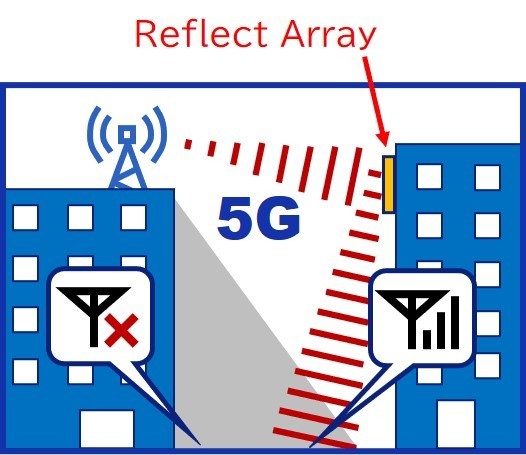Dai Nippon Printing develops means to expand 5G coverage area

Dai Nippon Printing Co Ltd (DNP) has developed a Reflect Array that flexibly reflects the millimeter waves used in fifth generation (5G) mobile communications systems to expand coverage area.
Compared to general metal reflectors, the new product is capable of reflecting millimeter waves in a more targeted manner. As a result, there are fewer restrictions on installation, making it possible to improve the communications environment in locations where radio waves have been difficult to reach, such as those in the shadow of buildings. In addition, the new product boasts superior design features allowing it to respond to various installation environment considerations.
Background
The 24GHz and above radio waves used in the high-speed large-capacity communications of 5G are higher frequency milliwaves than those used in 4G, and maintain a larger information capacity. At the same time, they are characterized by strong straightness properties and short reach, leading to radio waves being blocked in areas such as in the shadow of buildings making it difficult to ensure communication quality. Also, when adding base stations and relay equipment to resolve this issue, new challenges emerge, such as large costs and the difficulty of securing installation space.
DNP has once again risen to the challenge, taken advantage of proprietary microfabrication technology, and by applying an original concept has successfully separated the Frequency Selection Reflection Layer that selectively reflects predetermined frequency bands while merely passing through other radio waves, and the Reflective Direction Control Layer, a special dielectric layer that decides the direction of incoming and reflected radio waves, to develop a Reflect Array that makes it easier to control for the characteristics of each layer. The newly developed product is cheaper than installing base stations and relay equipment, and does not require a power source. It can, therefore, be installed in a variety of location, which contributes to significant improvements in the 5G communications environment.
Features
Unlike metal reflectors that reflect radio waves directly as in a mirror, the newly developed product is a reflective array capable of the asymmetric reflection of specific frequency radio waves. It is possible to flexibly set the frequency band to be reflected, the incidence angle of the radio waves received from the base station, and the reflection angle to deliver the radio waves, along with the spread of the reflection waves. As a result, it is now possible to effectively deliver radio waves to locations where it was previously difficult to do so. As a power source is no longer needed the new product can also be used in locations where installation space is restricted.
The new product is comprised of three layers: the Frequency Selective Surface Layer that selectively reflects predetermined frequency bands while merely passing through other radio waves, the Reflective Direction Control Layer that decides the direction of incoming and reflected radio waves, and a Design Cover Layer that not only protects these two layers, but also provides the durability required of construction materials along with high level design features that are conducive to various installation environment considerations.
Unlike metal reflectors that reflect all radio waves, the new product passes through all but target radio waves, reducing the impact on existing radio waves.
It is possible to print various patterns on the surface of the Design Cover Layer, making it possible to add external designs, including interior, exterior and advertising signboards.
DNP says more companies and organizations are considering the adoption of 5G as a means of targeting the realization of smart cities and smart factories that exploit robots and the Internet of Things (IoT). Commercialization efforts are already underway. With the development of the Reflect Array, it anticipates the following installation instances in cases where the radio wave environment is expected to deteriorate due to obstacles, and aim to link these initiatives to the spread of 5G.
Source: japantoday.com
